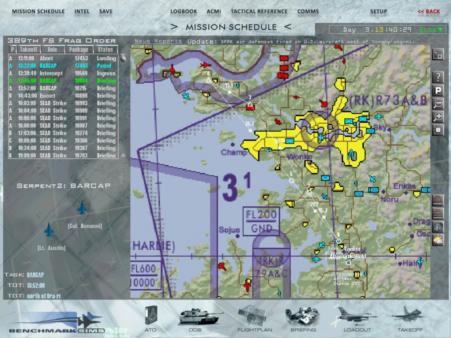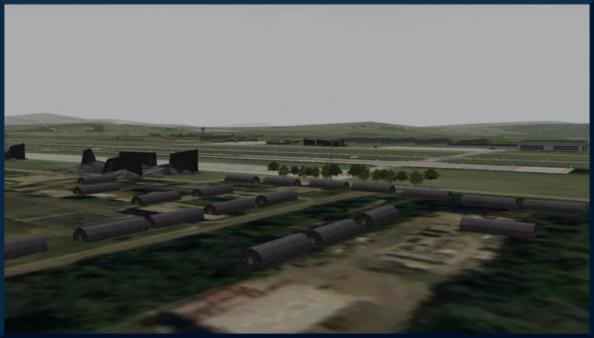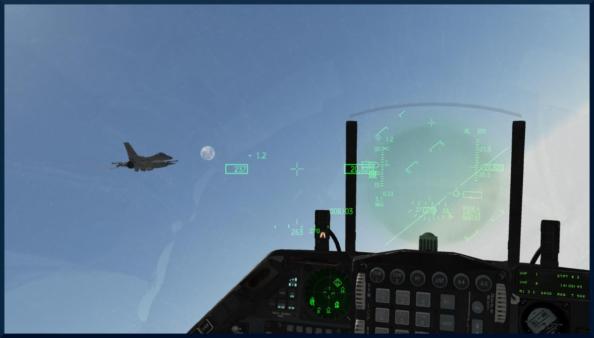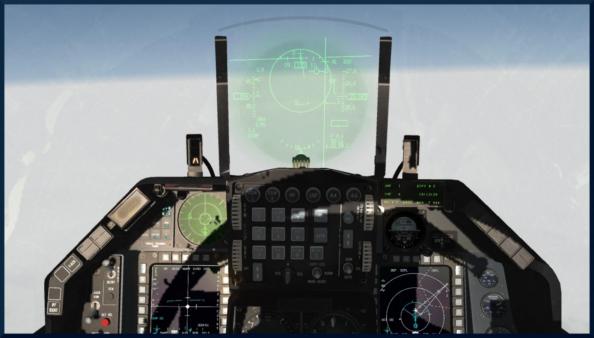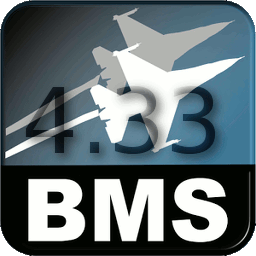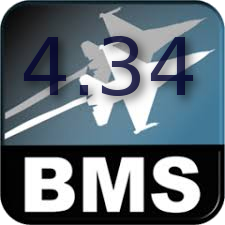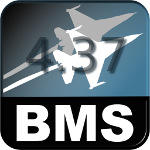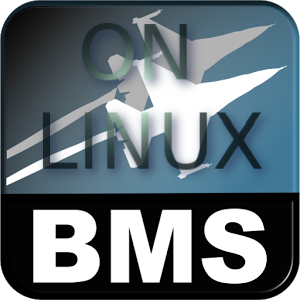FliersHaveMerit
Fliers have merit, those meritorious fly, those who don't fly have no merit!
Falcon 4 BMS
In the world of PC flight simulators, the title Falcon is almost as old as computers capable of graphical display good enough to even remotely portray a cockpit, an instrument panel and the outside world. Back in the day simmers needed far more imagination than today, and yet it appeared that nothing better will ever be made. Those who bothered to take a look at the credits page in each of Falcon incarnations must have noticed the name Louie Gilman, a man who is mentioned here for the significant role he played in the development of this series of flight sims. The first Falcon was published for the Amiga, Atari ST and 286 PC computers back in 1987. Falcon 3.0 was published in the year 1991. and, as a minimum, required a 386 CPU with a math coprocessor. At a later date, MiG- 29 simulator was published by the Spectrum Holobyte company which facilitated for online flying with Falcon 3.0 users and, as a consequence, flight simmers were able to fly F- 16s against MiG- 29s in the virtual skies. A VHS tape was delivered with Falcon 3.0 containing the Art Of The Kill video in which a real world F- 16 pilot and an author Pete Bonani, a man who will later have a significant role in the development of Falcon 4.0 just like Louie Gilman, instructed simmers on the basics of aerial combat. Some time between publishing Falcon 3.0 and it's sequel, and Falcon 4.0 was published in the year 1998., PC hardware became powerful enough to provide for the systems on the F- 16 fighter to be modeled with a high degree of fidelity, for the flight model to become more advanced and for the graphics display on computer monitors to be almost photo- realistic. In other words, it no longer took a stretch of imagination to consider Falcon 4.0 a flight simulator although the state it was published in wasn't perfect. After the Hasbro Interactive company ceased further development of this simulator the work was continued by enthusiasts who corrected the deficiencies, brought the graphics engine up to Direct X 9.0 standard, built an advanced force based flight model, modeled systems which weren't modeled before such as the data transfer cartridge, Sniper targeting pod, GPS guided munitions and so on. Falcon BMS is an F- 16 simulator first and foremost, but work was started on modeling other airplanes of which the work on the A-10 attack airplane can be considered the most complete. The A- 10 modeled in Falcon BMS offers a clickable 3D cockpit and an advanced flight model with the only conspicuous drawback being small differences in avionics modeling such as the HUD symbology.
Falcon BMS- dynamic campaign's user interface
Regarding single missions, Falcon BMS comes supplied with a rich set of choices. The "instant Action" option selectable from the main menu represents an arcadish mode which provides the user with the possibility of jumping into the cockpit and taking on computer generated targets immediately. "Dogfight" option allows the user to select the number of own and adverse aeroplanes oneself, types of aeroplanes, armament for both sides as well as the starting conditions of the engagement and can therefore be considered suitable for air combat tactics practice. The "Tactical Engagement" option contains a mission editor as well as training missions that represent the basic training curriculum. Falcon's dynamic campaign, unsurpassed in the world of PC flight simulators, can be accessed by selecting the "Campaign" option in the main menu. This campaign lets the user play the role of a pilot in a conflict which will develop depending on balance of power and skill level of the conflicting sides, which are adjustable by the user at the start of the campaign, as well as on the success of one of the sides in an attempt to achieve air supremacy, destroy the enemy's air defence network, disrupt supply lines, destroy war materials and weaponry production facilities, command centres, destroy enemy units and protect one's own. User's success in accomplishing user flown missions , as well as frequency of user flown missions with respect to the time flow in the campaign, will dictate the success of other AI controlled aeroplanes as well as other AI controlled units on the user's side. Simulated aeroplane flown by the simmer moves over the virtual battlefield in a centre of a bubble outside the boundaries of which battles are decided by the laws of statistics and probability, while the units inside the bubble, be they aerial, land or naval get displayed in the virtual world, maneuver and exchange fire, and consequently, an occasional tank battle on the terrain which is being over flown, an artillery barrage, an air defence unit in action or an aerial battle which will, perhaps, remain beheld will not escape the eye of a careful observer. The artificial intelligence controlling the units relevant to the action within the bubble uses realistic tactics, thanking to realistic modelling of weapon systems at it's disposal among other things, and consequently the simmer will be required to use realistic tactics in one's own realistically modelled fighter if one wishes to survive and win. The computer generates all missions in the dynamic campaign including those flown by the user, but, for want of excelling as a strategist, the user is left with the possibility of deleting all missions generated by the computer at any moment over the course of a campaign, or even disabling automatic mission generating at the very start of the campaign, and creating every mission for every type of aerial vehicle on one's own side. Falcon's dynamic campaign can be flown online, but the wish not to fly it solely in cooperative mode, unless it's flown in the Aegean theater of operations since both Greece and Turkey have F- 16s at their disposal, will put the simmer in the cockpit of a Sukhoi or a MiG with a full suite of F- 16s avionics or, even worse, have one fly a red fighter with an F- 16 cockpit as well. All red fighters still have the standard flight model. Apart from the Korean theater of operations Falcon BMS can be expanded with Israeli, Balkans, Iraqi and, perhaps, one or two more theaters of operations.
The Airborne Video Tape Recorder (AVTR), a standard system on the F- 16 fighter, can be switched on by fliping the Appropriate switch in the cockpit to the on position. The record of the flight can be accessed by selecting the ACMI option in the main menu and the user will be presented with relevant data for each object, human or AI controlled, which was in the bubble during the simulation. This option proves very useful on training flights, especially while exercising air combat tactics, because it facilitates for the engagement to be studied to the smallest detail: it is possible to display altitude and airspeed, turn radius and the rate of turn, the existence of a radar lock indicated by a radar lock line as well as display the flight path graphically at any moment during the recorded engagement. Launched weapons along with relevant data will also be displayed. Distance of any object from the object of interest is also displayed. AVTR will work perfectly in the dynamic campaign, and those curious may find it interesting to check whether more than they assumed happened in their proximity.
Falcon BMS- the outside world
Depiction of the outside world, when inspected closely, sometimes betrays this simulator's age. Grass isn't drawn on the ground, the terrain isn't densely populated by forests although tree models have been added by modders with the exception of areas frequently over flown or looked upon through the targeting pod such as the airbases, while populated areas, only scarcely populated by building models, remain depicted mostly by textures. On the other hand, as already stated, a real life F- 16 pilot advised while the simulator was in development and helped make all the right compromises in many areas. The simmer will spend most of one's time above 10000 feet which justifies depicting forested and populated areas with textures, while low altitude flight makes the aforementioned compromises a bit more conspicuous. Grass remains indiscernible at air speeds the F- 16 cruises at and, for the sake of comparison, those interested can take a look at a HUD tape recorded in a real F- 16. If the fact that the pilot's attention is tied to the cockpit instruments and displays most of the time is taken into account, it becomes clear that little time remains to enjoy the scenery. Effort has been invested into depicting the important portion of the outside world, and consequently, tank battles most probably look like real tank battles when looked upon from a higher altitude, other airplanes become visible at distances at which they become visible in the real world, while their maneuvering, visibility against the terrain or against the sky, as well as head on passes, leave a good impression on people who visited an air show or watched an aviation related movie. Cockpit displays of the Sniper targeting pod, FLIR or AGM- 65 missiles look rather close to corresponding displays visible in video clips recorded in the real F- 16, and available on Youtube. If the fact is considered that a large portion of processor cycles is necessary to model flight, systems and weapons on the simulated airplane, other airplanes as well as other units that take part in the virtual conflict, the decision to depict only the necessary minimum of ground objects appears good. The graphics engine of Falcon BMS will deliver more than credible graphics nevertheless. In addition, this simulator has a dynamic atmosphere model, and the simmer who took off in sunny weather may face reduced visibility, rain or strong side winds while landing or delivering payload.
Falcon BMS- formation flying
Until the BMS add on for Falcon 4.0 was published, this simulator was frequently reprimanded with leaving the simmer with the impression that the simulated aeroplane was "on rails", having it's table based flight model to thank for this. BMS add on introduced a new force based flight model which solves differential equations of motion of an aeroplane in real time, taking into account movements of Center of Gravity consequential to fuel expenditure or payload detaching as well. Since the F- 16 is an aerodynamically unstable aeroplane which uses Fly By Wire to provide for longitudinal stability, FLCS of the real fighter, published by NASA, was implemented over the aforementioned advanced flight model. Flight characteristics of the F- 16 fighter modeled to a high degree of fidelity were the result and, it shouldn't be forgotten, advanced flight models have also been created for the A- 10, the F- 18 and the F- 14 which, reportedly, haven't been developed in as small a detail as the advanced flight model built for the F- 16. The advanced flight models allow the simmer to acquaint oneself with the sustained performance of the simulated aeroplane, as well as with the behaviour it owes to it's stability and control characteristics. Rolling moment induced by asymmetric wing loading consequential to, perhaps, dropping the payload under a single wing, yawing moment induced by firing the cannon outside the Mach number margin between 0,7 and 0,9 within which the FLCS will compensate for said moment, the possibility to introduce even an F- 16 into a spin under certain circumstances as well as realistic behaviour during taxiing, take off and landing represent only a few among a greater number of situations which will let the virtual pilot know that Falcon BMS is, in fact, a completely new simulator regarding flight modelling. Combat flight simulators are expected to model the influence battle damage has on flight characteristics of the simulated aeroplane. For instance, damage on one wing should induce asymmetric wing loading, which boils down to flight model and damage model interaction. Wing damage won't be visible in Falcon BMS but, in some instances, a AAA shell explosion will only induce a rolling moment. In a greater number of cases the simmer will have to trim all controls in order to keep the aeroplane even remotely controllable. Visible damage remains limited to smoke emission of a damaged engine and failing cockpit instruments.
Falcon BMS- clickable cockpit
While modelling cockpit instruments and displays has always been a standard in the world of PC flight simulators, a more recent trend of developping clickable cockpits, such that each button, switch or knob in the cockpit can be activated with the mouse and have the same function as it's real life counterpart, has developed. This, coupled with the usage of head- tracking systems or virtual reality head sets, eliminates the need to build a physical model of the cockpit while retaining the possibility of learning proper cockpit procedures. Falcon 4.0, when it was published, didn't have a clickable 3D cockpit, but it's 2D cockpit was partly clickable and, as a consequence, one can consider this simulator a part of the reason for setting the current trend in cockpit modelling. Falcon BMS comes equipped with a clickable 3D cockpit in which functions of only a few less significant switches aren't implemented yet, which provides for learning proper cockpit procedures, be it the RAMP start procedure or individual systems usage procedures. Off course, support for head- tracking with six degrees of freedom has been implemented, while announcements for Occulus Rift support have been perceived. Apart from the systems which can be expected in a civilian flight simulator such as the INS, radio- beacon navigation systems or ILS, Falcon BMS contains models of sensors and weaponry present in the F- 16 inventory which make this simulator more interesting when compared with civilian flight simulators. Pulse- Doppler radar model provides for breaking the radar lock when closing speed of the fighter that has been locked up relative to the fighter that locked it up is close to the closing speed of the ground in a look- down situation, or when closing speed of one fighter relative to another has a value close to zero, which imposes the need to use realistic tactics with all considerations this forces on a pilot while using medium range missiles or trying to avoid them. Since IR seeker head sensitivity has been modelled, throttling back out of afterburner and approaching an adversary equipped with IR guided missiles at an altitude lower than that of the opposing fighter will delay the moment at which the missile seeker gets a good lock on the approaching fighter, while maneuvering under the horizon line in relation to the adversary and dispensing flares creates further difficulties for an opponent attempting to acquire good launch parameters, which is to say that the weaponry model is realistic in this area as well and that the pilot applying realistic tactics will be more successful. On an unguided bomb delivery run the wind, if strong, can prevent the Fire Control Computer from reaching a firing solution in the Continusly Computed Release Point mode for which reason, just like in the real F- 16, the Data Entry Display on which speed and direction of the wind can be displayed by pressing the SEQ key on the Integrated Control Panel, Horizontal Situation Indicator on which the course deviation bar can be set to match the direction of the wind as well as the Visual Ingress Point and the Visual Release Point, which can be programmed through the Integrated Control Panel and Data Entry Display and displayed as symbols on the Heads Up Display, have been modelled. Off course, if laser or GPS guided munitions are used, speed and direction of the wind loose their significance but things become less interesting. One could write more about the need to switch the power on for the AGM- 65 missiles, to turn on seeker head cooling for all- aspect air- to- air IR guided missiles, to set the burst altitude for cluster bombs, to program the Data Transfer Cartridge, but it has all been written and is delivered as documentation with Falcon BMS.
Falcon BMS add on for Falcon 4.0 was patched seven times and is, along with Falcon 4.0 .exe file, all that's needed to install and run this simulator. Those interested can find this add on, patches, add on terrains and other mods on Benchmark Sims website.
Related to this flightsim:
If You are ready to get pumped visit totally sweet mammels, or the following website.

